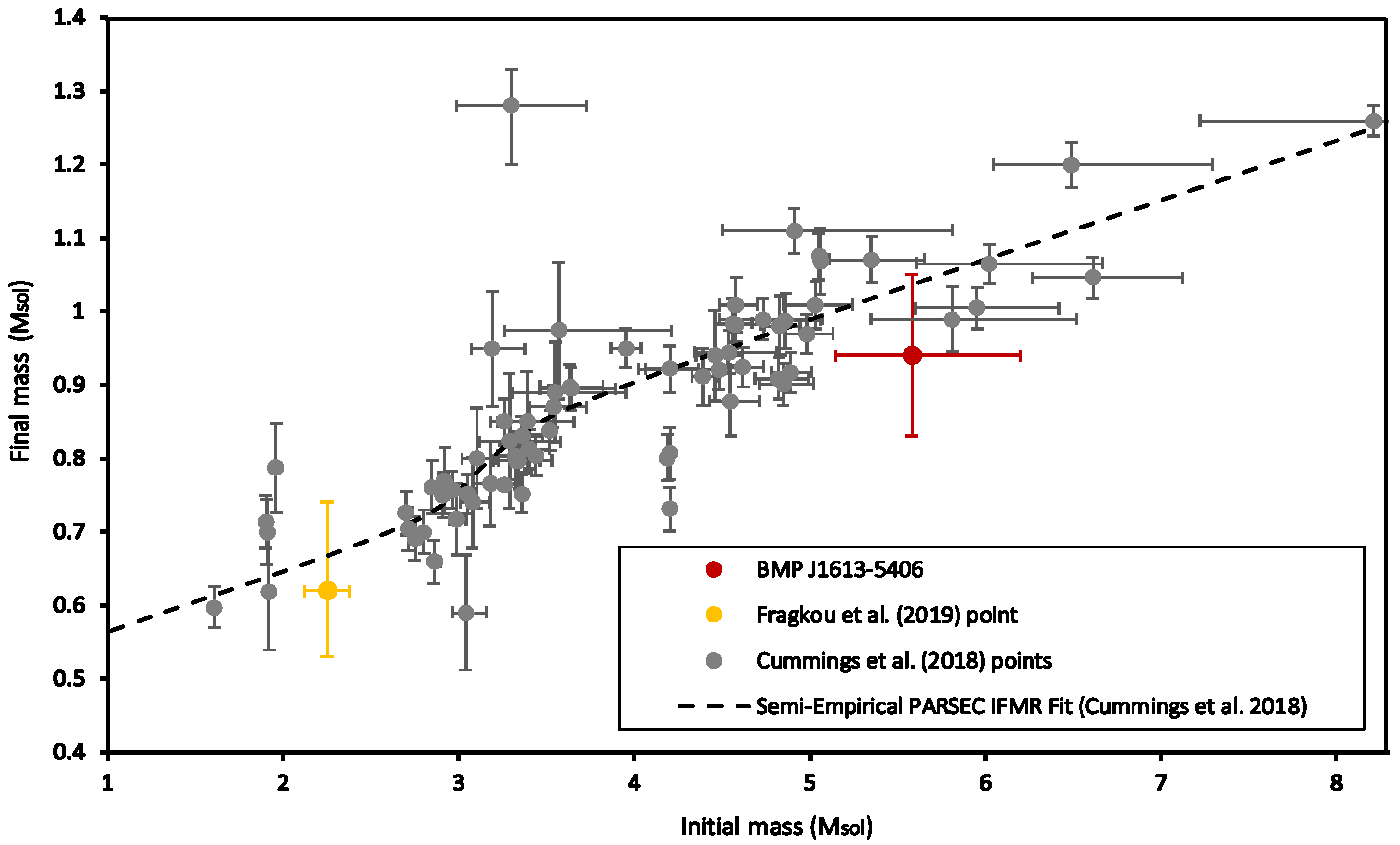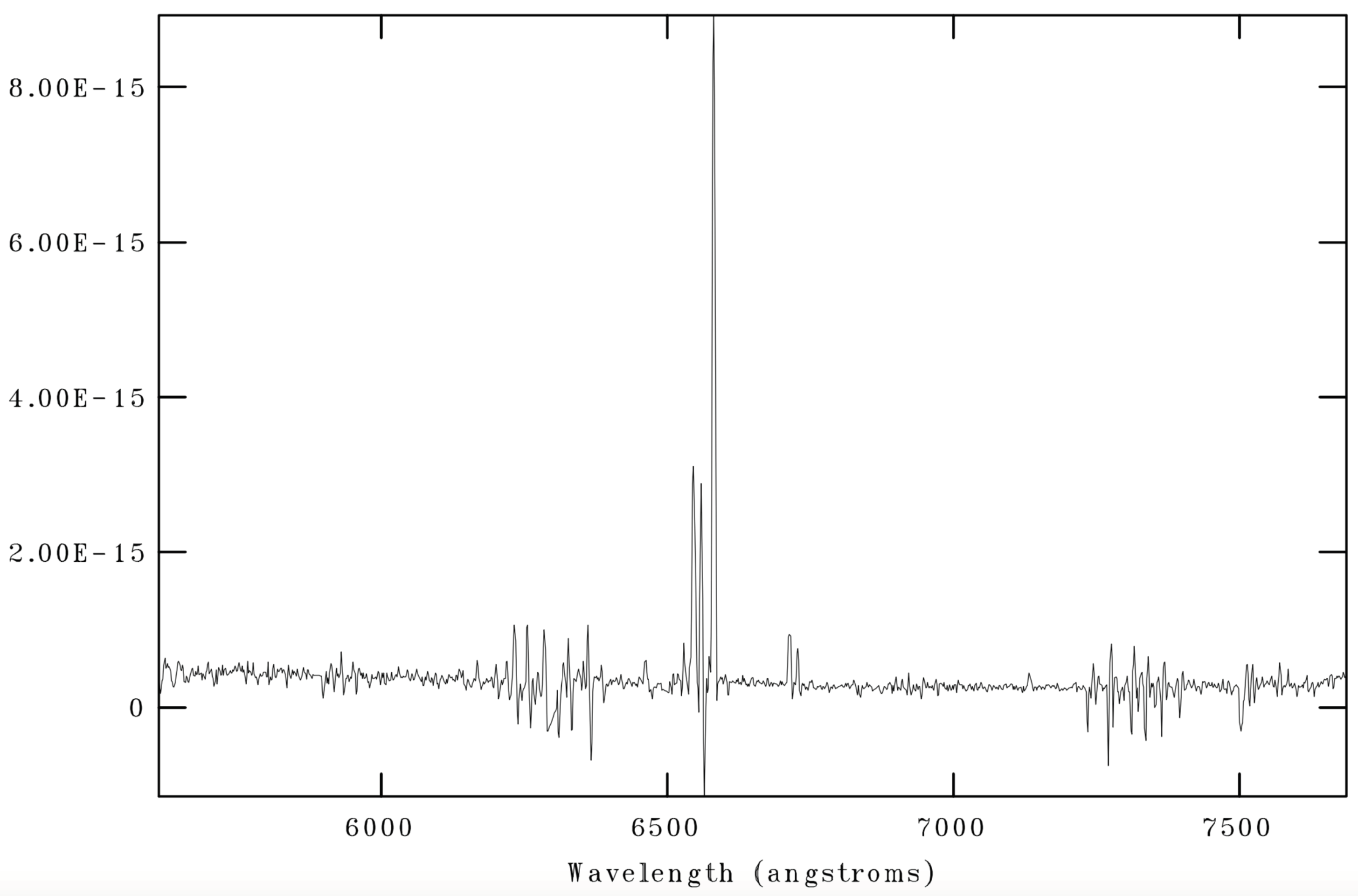Further Studies of the Association of Planetary Nebula BMP J16135406 with Galactic Open Cluster NGC 6067
Abstract
:1. Introduction
2. Observations and Methods
3. Results
3.1. Demonstrating PN-Cluster Membership
3.2. The PN BMP J1613-5406
4. Discussion and Preliminary New Findings
Author Contributions
Funding
Data Availability Statement
Acknowledgments
Conflicts of Interest
References
- Gaia, Collaboration; Prusti, T.; de Bruijne, J.H.; Brown, A.G.; Vallenari, A.; Babusiaux, C.; Bailer-Jones, C.A.; Bastian, U.; Biermann, M.; Evans, D.W. The Gaia mission, A&A595 (2016) A1. arXiv 2016, arXiv:1609.04153. [Google Scholar] [CrossRef] [Green Version]
- Cummings, J.D.; Kalirai, J.S.; Tremblay, P.E.; Ramirez-Ruiz, E.; Choi, J. The white dwarf initial–final mass relation for progenitor stars from 0.85 to 7.5 M⊙. Astrophys. J. 2018, 866, 21. [Google Scholar] [CrossRef] [Green Version]
- Pease, F.G. A planetary nebula in the globular cluster Messier 15. Publ. Astron. Soc. Pac. 1928, 40, 342. [Google Scholar] [CrossRef] [Green Version]
- Gillett, F.C.; Jacoby, G.H.; Joyce, R.R.; Cohen, J.G.; Neugebauer, G.; Soifer, B.T.; Nakajima, T.; Matthews, K. The optical/infrared counterpart(s) of IRAS 18333-2357. Astrophys. J. 1989, 338, 862–874. [Google Scholar] [CrossRef]
- Jacoby, G.H.; Morse, J.A.; Fullton, L.K.; Kwitter, K.B.; Henry, R.B.C. Planetary nebulae in the globular cluster PAL 6 and NGC 6441. Astron. J. 1997, 114, 2611. [Google Scholar] [CrossRef]
- Parker, Q.A.; Frew, D.J.; Miszalski, B.; Kovacevic, A.V.; Frinchaboy, P.M.; Dobbie, P.D.; Köppen, J. PHR 1315–6555: A bipolar planetary nebula in the compact Hyades-age open cluster ESO 96-SC04. Mon. Not. R. Astron. Soc. 2011, 413, 1835–1844. [Google Scholar] [CrossRef] [Green Version]
- Fragkou, V.; Parker, Q.A.; Zijlstra, A.; Shaw, R.; Lykou, F. The central star of planetary nebula PHR 1315–6555 and its host Galactic open cluster AL 1. Mon. Not. R. Astron. Soc. 2019, 484, 3078–3092. [Google Scholar] [CrossRef] [Green Version]
- Fragkou, V.; Parker, Q.A.; Zijlstra, A.A.; Crause, L.; Barker, H. A high-mass planetary nebula in a Galactic open cluster. Nat. Astron. 2019, 3, 851–857. [Google Scholar] [CrossRef]
- Davis, B.D.; Bond, H.E.; Ciardullo, R.; Jacoby, G.H. Hubble Space Telescope Spectroscopy of a Planetary Nebula in an M31 Open Cluster: Hot-Bottom Burning at 3.4 M⊙. arXiv 2019, arXiv:1909.08007. [Google Scholar] [CrossRef] [Green Version]
- Alonso-Santiago, J.; Negueruela, I.; Marco, A.; Tabernero, H.M.; González-Fernández, C.; Castro, N. NGC 6067: A young and massive open cluster with high metallicity. Mon. Not. R. Astron. Soc. 2017, 469, 1330–1353. [Google Scholar] [CrossRef] [Green Version]
- Netopil, M.; Paunzen, E.; Heiter, U.; Soubiran, C. On the metallicity of open clusters-III. Homogenised sample. Astron. Astrophys. 2016, 585, A150. [Google Scholar] [CrossRef] [Green Version]
- Piskunov, A.E.; Schilbach, E.; Röser, S.; Scholz, R.D. The MWSC survey is only available at the CDS via anonymous ftp to cdsarc. u-strasbg. fr (130.79. 128.5) or via http://cdsarc.u-strasbg.fr/viz-bin/qcat?J/A+A/558/A53. Astron. Astrophys. 2013, 558, A53. [Google Scholar] [CrossRef] [Green Version]
- Majaess, D.; Sturch, L.; Moni Bidin, C.; Soto, M.; Gieren, W.; Cohen, R.; Mauro, F.; Geisler, D.; Bonatto, C.; Borissova, J.; et al. Anchors for the cosmic distance scale: The Cepheid QZ Normae in the open cluster NGC 6067. Astrophys. Space Sci. 2013, 347, 61–70. [Google Scholar] [CrossRef] [Green Version]
- Turner, D.G. The PL calibration for Milky Way Cepheids and its implications for the distance scale. Astrophys. Space Sci. 2010, 326, 219–231. [Google Scholar] [CrossRef] [Green Version]
- Mermilliod, J.C.; Mayor, M.; Udry, S. Red giants in open clusters-XIV. Mean radial velocities for 1309 stars and 166 open clusters. Astron. Astrophys. 2008, 485, 303–314. [Google Scholar] [CrossRef] [Green Version]
- Piskunov, A.E.; Schilbach, E.; Kharchenko, N.V.; Röser, S.; Scholz, R.D. Tidal radii and masses of open clusters. Astron. Astrophys. 2008, 477, 165–172. [Google Scholar] [CrossRef] [Green Version]
- An, D.; Terndrup, D.M.; Pinsonneault, M.H. The Distances to Open Clusters from Main-Sequence Fitting. IV. Galactic Cepheids, the LMC, and the Local Distance Scale. Astrophys. J. 2007, 671, 1640. [Google Scholar] [CrossRef] [Green Version]
- Mermilliod, J.C.; Mayor, M.; Burki, G. Membership of cepheids and red giants in 8 open clusters: NGC 129, 6067, 6087, 6649, 6664, IC 4725, LY 6, RU 79. Astron. Astrophys. Suppl. 1987, 70, 389. [Google Scholar]
- Coulson, I.M.; Caldwell, J.A. The Cepheid HD 144972 and the problematic distance to the open cluster NGC 6067. Mon. Not. R. Astron. Soc. 1985, 216, 671–678. [Google Scholar] [CrossRef] [Green Version]
- Walker, A.; Coulson, I.M. CCD photometry of galactic clusters containing Cepheid variables. Paper 3: Photometry and identification charts for NGC 6067. SAAOC 1985, 9, 97–110. [Google Scholar]
- Walker, A.R. CCD photometry of galactic clusters containing Cepheid variables–II. NGC 6067. Mon. Not. R. Astron. Soc. 1985, 214, 45–53. [Google Scholar] [CrossRef] [Green Version]
- Mermilliod, J.C. Comparative studies of young open clusters. Astron. Astrophys. 1981, 97, 235. [Google Scholar]
- Mermilliod, J.-C. Comparative studies of young open clusters. II. A atlas of composite colour-magnitude diagrams. Astron. Astrophys. Suppl. 1981, 44, 467. [Google Scholar]
- Thackeray, A.D.; Wesselink, A.J.; Harding, G.A. The cluster NGC 6067. Mon. Not. R. Astron. Soc. 1962, 124, 445. [Google Scholar] [CrossRef]
- Trumpler, R.J. 87. Preliminary Results on the Distances, Dimensions, and Space Distribution of Open Star Clusters (pp. 593–604). LicOB 1930, 420, 154. [Google Scholar] [CrossRef] [Green Version]
- Miszalski, B.; Parker, Q.A.; Acker, A.; Birkby, J.L.; Frew, D.J.; Kovacevic, A. MASH-II: More planetary nebulae from the AAO/UKST Hα survey. Mon. Not. R. Astron. Soc. 2008, 384, 525–534. [Google Scholar] [CrossRef] [Green Version]
- Barker, H.; Zijlstra, A.; De Marco, O.; Frew, D.J.; Drew, J.E.; Corradi, R.L.; Eislöffel, J.; Parker, Q.A. The binary fraction of planetary nebula central stars-III. the promise of VPHAS+. Mon. Not. R. Astron. Soc. 2018, 475, 4504–4523. [Google Scholar] [CrossRef] [Green Version]
- Frew, D.J.; Parker, Q.A.; Bojicic, I.S. The Hα surface brightness—Radius relation: A robust statistical distance indicator for planetary nebulae. Mon. Not. R. Astron. Soc. 2016, 455, 1459–1488. [Google Scholar] [CrossRef] [Green Version]
- Frew, D.J.; Bojičić, I.S.; Parker, Q.A. A catalogue of integrated Hα fluxes for 1258 Galactic planetary nebulae. Mon. Not. R. Astron. Soc. 2013, 431, 2–26. [Google Scholar] [CrossRef] [Green Version]
- Frew, D.J.; Bojičić, I.S.; Parker, Q.A.; Pierce, M.J.; Gunawardhana, M.L.; Reid, W.A. Flux calibration of the AAO/UKST superCOSMOS Hα survey. Mon. Not. R. Astron. Soc. 2014, 440, 1080–1094. [Google Scholar] [CrossRef] [Green Version]
- Peimbert, M.; Torres-Peimbert, S. Type I planetary nebulae. IAUS 1983, 103, 233. [Google Scholar]
- Parker, Q.A.; Phillipps, S.; Pierce, M.J.; Hartley, M.; Hambly, N.C.; Read, M.A.; MacGillivray, H.T.; Tritton, S.B.; Cass, C.P.; Cannon, R.D.; et al. The AAO/UKST SuperCOSMOS Hα survey. Mon. Not. R. Astron. Soc. 2005, 362, 689–710. [Google Scholar] [CrossRef] [Green Version]
- Pottasch, S.R. Local space density and formation rate of planetary nebulae. Astron. Astrophys. 1996, 307, 561. [Google Scholar]
- Dopita, M.A.; Meatheringham, S.J. The evolutionary sequence of planetary nebulae. Astrophys. J. 1990, 357, 140–148. [Google Scholar] [CrossRef]
- Reid, W.A.; Parker, Q.A. An evaluation of the excitation-class parameter for the central stars of planetary nebulae. Publ. Astron. Soc. Aust. 2010, 27, 187–198. [Google Scholar] [CrossRef] [Green Version]
- Kaler, J.B.; Jacoby, G.H. Central star temperatures of optically thick planetary nebulae and a distance-independent test of dredge-up theory. Astrophys. J. 1989, 345, 871–880. [Google Scholar] [CrossRef]
- Weston, S.; Napiwotzki, R.; Sale, S. Central stars of Planetary Nebulae in SDSS and IPHAS. J. Phys. Conf. Ser. 2009, 172, 012033. [Google Scholar] [CrossRef]
- Karakas, A.I.; Lugaro, M. Stellar yields from metal-rich asymptotic giant branch models. Astrophys. J. 2016, 825, 26. [Google Scholar] [CrossRef]
- Zanstra, H. Untersuchungen über planetarische Nebel. Erster Teil: Der Leuchtproze & beta planetarischer Nebel und die Temperatur der Zentralsterne. Mit 4 Abbildungen. Z. Astrophys. 1931, 2, 1. [Google Scholar]





| PN Property | Estimated Value |
|---|---|
| Major and Minor diameter | 335 × 215 arcseconds |
| Statistical distance | kpc |
| Physical radius | 1.27 pc |
| Ionized PN mass | 0.56 |
| Expansion velocity | 40.5 km/s |
| Kinematic age | 30,600 yrs |
| Excitation class | 5–7.3 |
| Excitation class | >4.3 |
| CS mag | 20.3–21.4 |
| CS temperature | 125–190 kK |
| CS temperature (from ) | >81 kK |
| CS mass | 0.94 ± 0.11 |
| Element (X) | log(X/H) |
|---|---|
| He | −1.10 |
| Ne | −3.79 |
| O | −3.21 |
| N | −3.26 |
| S | −4.78 |
| Ar | −5.33 |
| Filter | Mag |
|---|---|
| U | 19.20 ± 0.28 |
| B | 19.67 ± 0.03 |
| V | 19.99 ± 0.04 |
| R | 19.26 ± 0.05 |
| I | 18.99 ± 0.12 |
Publisher’s Note: MDPI stays neutral with regard to jurisdictional claims in published maps and institutional affiliations. |
© 2022 by the authors. Licensee MDPI, Basel, Switzerland. This article is an open access article distributed under the terms and conditions of the Creative Commons Attribution (CC BY) license (https://creativecommons.org/licenses/by/4.0/).
Share and Cite
Fragkou, V.; Parker, Q.A.; Zijlstra, A.A.; Crause, L.; Sabin, L.; Vázquez, R. Further Studies of the Association of Planetary Nebula BMP J16135406 with Galactic Open Cluster NGC 6067. Galaxies 2022, 10, 44. https://doi.org/10.3390/galaxies10020044
Fragkou V, Parker QA, Zijlstra AA, Crause L, Sabin L, Vázquez R. Further Studies of the Association of Planetary Nebula BMP J16135406 with Galactic Open Cluster NGC 6067. Galaxies. 2022; 10(2):44. https://doi.org/10.3390/galaxies10020044
Chicago/Turabian StyleFragkou, Vasiliki, Quentin A. Parker, Albert A. Zijlstra, Lisa Crause, Laurence Sabin, and Roberto Vázquez. 2022. "Further Studies of the Association of Planetary Nebula BMP J16135406 with Galactic Open Cluster NGC 6067" Galaxies 10, no. 2: 44. https://doi.org/10.3390/galaxies10020044
APA StyleFragkou, V., Parker, Q. A., Zijlstra, A. A., Crause, L., Sabin, L., & Vázquez, R. (2022). Further Studies of the Association of Planetary Nebula BMP J16135406 with Galactic Open Cluster NGC 6067. Galaxies, 10(2), 44. https://doi.org/10.3390/galaxies10020044







